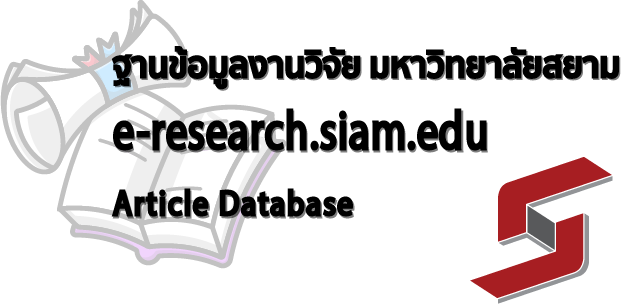- KB Home
- หลักสูตรปริญญาตรี|Bachelor Degree
- คณะวิทยาศาสตร์
- -สาขาวิชาเทคโนโลยีการอาหาร
- ศึกษาวิธีการสกัดและสมบัติทางเคมีกายภาพของโปรตีนพืชในการประยุกต์ใช้ในผลิตภัณฑ์เลียนแบบเนื้อสัตว์
| ชื่อบทความ: | ศึกษาวิธีการสกัดและสมบัติทางเคมีกายภาพของโปรตีนพืชในการประยุกต์ใช้ในผลิตภัณฑ์เลียนแบบเนื้อสัตว์ |
| Research Article: | Study on Extraction Methods and Physicochemical Properties of Plant-Based Proteins in Application of Meat Imitation Products |
| ผู้เขียน|Author: | ธัญญาภรณ์ ศิริเลิศ, มัทวัน ศรีอินทร์คำ และ ณัฎฐิกา ศิลาลาย | Tunyaporn Sirilert, Mattawan Sri-inkum and Nattiga Silalai |
| Email: | tunyaporn.sir@siam.edu ; nattiga.sil@siam.edu |
| ภาควิชา|คณะ: | ภาควิชาเทคโนโลยีการอาหาร คณะวิทยาศาสตร์ มหาวิทยาลัยสยาม กรุงเทพฯ 10160 |
| Department|Faculty: | Department of Food Technology, Faculty of Science, Siam University, Bangkok 10160 |
| Published|แหล่งเผยแพร่: | วารสารวิทยาศาสตร์บูรพา ปีที่ 28 (ฉบับที่ 3) กันยายน – ธันวาคม พ.ศ. 2566|Burapha Science Journal, Volume 28 (No.3) September – December 2023 |
การอ้างอิง|Citation
ธัญญาภรณ์ ศิริเลิศ, มัทวัน ศรีอินทร์คำ และ ณัฏฐิกา ศิลาลาย. (2566). ศึกษาวิธีการสกัดและสมบัติทางเคมีกายภาพของโปรตีนพืชในการประยุกต์ใช้ในผลิตภัณฑ์เลียนแบบเนื้อสัตว์. วารสารวิทยาศาสตร์บูรพา, 28(3), 1424-1444.
Sirilert T., Sri-inkum M. and Silalai N. (2023). Study on extraction methods and physicochemical properties of plant-based proteins in application of meat imitation products. Burapha Science Journal, 28(3), 1424-1444.
บทคัดย่อ
วัตถุประสงค์ของการศึกษาวิจัย คือ เพื่อตกตะกอนโปรตีนและนำไปประยุกต์ใช้ในผลิตภัณฑ์โปรตีนพืชเลียนแบบเนื้อสัตว์ เบื้องต้นมีการศึกษากรรมวิธีในการกำจัดกลิ่นถั่วเหลืองที่ใช้เป็นแหล่งโปรตีนในอาหาร พบว่า ถั่วที่แช่ด้วย 0.5% CaCO3 มีการกำจัดกลิ่นถั่วได้ดีที่สุด และประสิทธิภาพในการตกตะกอนโปรตีนจากถั่วเหลืองด้วย 1% Glucono delta lactone (GDL) ให้ปริมาณโปรตีนสูงสุด 50.04% แต่ให้รสขมตกค้าง รองลงมาคือ 3% MgSO4 : NaCl (2 : 1) ให้ปริมาณโปรตีน 44.51% (p ≤ 0.05) โดย MgSO4 : NaCl (2 : 1) เข้มข้น 3% ถูกคัดเลือกใช้ในการผลิตเนื้อสัตว์จากพืชแบบปริมาณโปรตีนสูง พบว่าสูตร A ที่ใช้โปรตีนพืชของของเห็ดแครงต่อเห็ดเข็มทองในอัตราส่วน 70 : 30 ให้ปริมาณโปรตีนสูงสุด 20.61% (p ≤ 0.05) และเมื่อพัฒนาเนื้อสัมผัสด้วยการใช้กระบวนการร่วม 2 วิธี คือ การแช่เยือกแข็ง (Freezing; AF) และการใช้แรงเฉือน (Shearing; AS) เปรียบเทียบกับตัวอย่างควบคุมคือเนื้อหมู พบว่า ค่าการเกาะติดของโครงสร้าง (Cohesiveness) ของเนื้อหมูมีค่าน้อยที่สุด ขณะที่เส้นใยโปรตีนพืชจะให้ค่าความยืดหยุ่น (Springiness) และความสามารถของการเคี้ยว (Chewiness) สูงกว่าเนื้อหมู นอกจากนั้นสูตร AS-70:30 ให้ค่าเนื้อสัมผัสและลักษณะปรากฏหลังการดูดกลับน้ำที่มีลักษณะใกล้เคียงกับเนื้อหมูสด โดยอัตราการดูดซับน้ำของทุกสิ่งทดลองมีมากค่ามากขึ้นตามระยะเวลาในการอบแห้งที่นานขึ้น
คำสำคัญ: ถั่วเหลือง การตกตะกอนโปรตีน เนื้อจากพืช การคืนตัว
ABSTRACT
The objectives of the present study were to precipitate protein from soybeans and apply it to in plant-based meat products. Preliminary studies have been conducted to eliminate the smell of soybeans in order to use them as a protein source in food. It was found that soybean odor elimination with 0.5% CaCO3 was the best method of odor removal. The efficiency of soybean protein precipitation with 1% GDL provided the highest protein content (50.04%), but it gave a residual bitter taste, followed by 3% MgSO4 : NaCl (2 : 1) providing 44.51% protein content (p ≤ 0.05). The ratio of MgSO4 : NaCl (2 : 1) at a 3% concentration was selected for the production of high protein plant-based meat. It indicated that formula A using a ratio of plant protein of cockle mushroom to Golden needle mushroom of 70:30 had the highest protein content of 20.61% (p ≤ 0.05). The texture of plant-based meat was developed by two processes, such as freezing (AF) and shearing (AS), and compared with the control sample (pork meat). It was found that the adhesion value (Cohesiveness) of pork meat was the least, while plant-based protein providing flexibility (Springiness) and the ability to chew (Chewiness) was higher than those of pork. In addition, the texture and appearance of the AS-70:30 after rehydration were similar to the fresh pork. The water absorption rate of all experimental data increased with the increasing in drying time.
Keywords: Soybeans, Protein precipitation, Plant-based meat, Rehydration.
ศึกษาวิธีการสกัดและสมบัติทางเคมีกายภาพของโปรตีนพืชในการประยุกต์ใช้ในผลิตภัณฑ์เลียนแบบเนื้อสัตว์
คณะวิทยาศาสตร์ มหาวิทยาลัยสยาม | Faculty of Science, Siam University, Bangkok, Thailand


